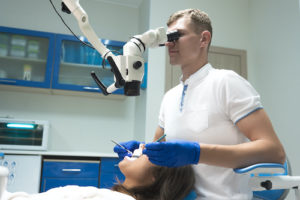Many people panic when they hear that they might need a root canal. While each root canal performed is slightly different based on the specific situation being addressed, there are some basic things to know about this procedure.
Who Performs Root Canal Treatment?
Endodontists are the dental specialists who are best suited to perform a root canal treatment. These doctors have completed an extra one to two years of special training to diagnose tooth pain and perform procedures to address the tooth’s inside, including root canals.
Instead of removing the tooth, endodontists directly treat the issue inside the tooth and any pain it brings. Typically, endodontists perform somewhere around twenty-five root canals per week. With all of the dental pulp disease that they see, they are experts in addressing it to minimize any risk of complications or other problems arising.
Endodontists are also experts at using local numbing agents to provide you with the most comfortable root canal procedure possible. At the same time, this minimizes your recovery time and helps you get back on your feet and move on with your day sooner.
Because Lovett Dental Northside keeps general dentists as well as a full range of specialists under one roof, it’s very easy to send you or a loved one to get evaluated by an endodontic specialist. Your endodontist can address any concerns you or your family may have, as well as develop a personalized treatment plan that makes the most sense for you.
How Is a Root Canal Detected?
Patients generally come in with a classic set of symptoms that point to a root canal’s need. Symptoms may include tooth pain that worsens with any applied pressure on or near the tooth, extreme sensitivity to hot or cold temperatures, a darkening of the tooth, and even little pimples on the gums near the tooth. These signs can all point to an infection on the interior of the tooth.
If you are suspected of needing a root canal, your endodontist will perform an x-ray of the tooth in question. This helps the doctor determine how severe the infection is and confirm where exactly it is located. Recent advances in technology can also allow them to take more advanced 3D imaging and map out the infection in greater detail. This allows doctors to see even the smallest parts of the tooth and be confident that they have accurately detected–and removed–all of the infected parts.
What Happens During Root Canal Treatment?
A hole is made into the tooth for a root canal treatment, and any diseased pulp is removed. This relieves the pain and takes away any infected parts of the tooth so that the problem can be brought under control. But there are a few steps to get this done.
Your endodontist has likely already taken some imaging studies of your teeth, but if any is still needed, those will come first. A numbing agent will be applied to that area of your mouth and will take a bit of time to kick in. While it starts to numb you, the tooth’s exterior will be cleaned, and a dental dam will be placed over it to keep the tooth free of saliva and other matter during the procedure.
Then, your doctor will drill a small hole into the bottom of your tooth and pull out any diseased nerve or pulp. From there, a filling will be placed over the hole. Either the same day as the procedure or on a subsequent visit, a crown may be placed over the tooth to seal it off.
Lovett Dental Northside
If you are thinking about getting better dental care for yourself and your family, Lovett Dental Northside can help. Our offices combine general family dentistry with over six different specialties to ensure you and your family can have any dental concerns addressed quickly and comfortably. Call us today at 713-691-5551, or contact us online to book your appointment.
